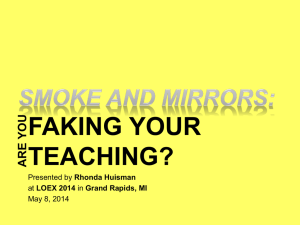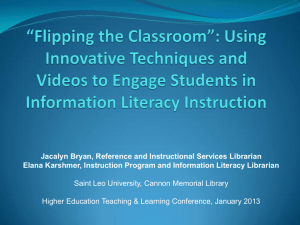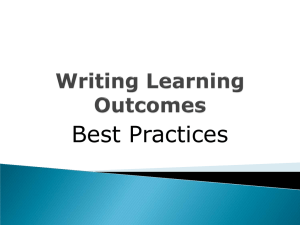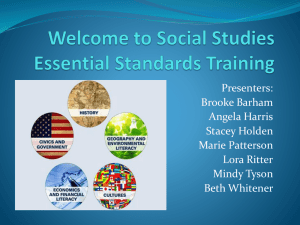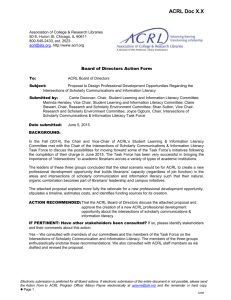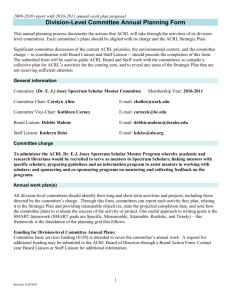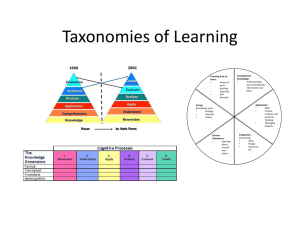Presentation - LOEX Annual Conference
advertisement
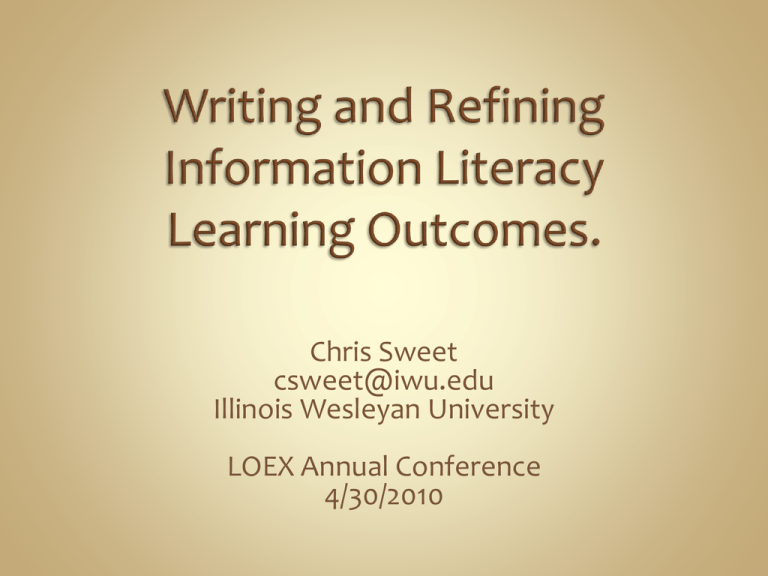
Chris Sweet csweet@iwu.edu Illinois Wesleyan University LOEX Annual Conference 4/30/2010 After this workshop participants will be able to: Articulate the importance of learning outcomes in higher education. Develop good learning outcomes for information literacy instruction in order to improve teaching and assessment. Advance information literacy initiatives on your campus through the use of learning outcomes. Do you currently have info lit learning outcomes in place? What are your learning outcome needs? (Instructional, departmental, programmatic?) Did you come with a specific session or class? What is your campus/library culture in regards to assessment? How many have written their own learning outcomes? Info Lit Librarian ACRL Immersion ACRL Assessment Workshop Info Lit Outcomes for Campus Writing Program Students value research as a discovery process that requires both creativity and persistence. Students locate, evaluate and synthesize diverse information resources in order to develop a body of evidence that supports the project’s purpose. Students demonstrate critical thinking and sound reasoning in their writing through the integration of credible, authoritative sources. Students utilize systems of documentation and acknowledgement in order to use information in an appropriate legal and ethical manner. Good learning outcomes are not something you research a bit and sit down at your desk and crank out. Identify the Stakeholders Teaching Faculty? Administrators? Librarians? Brainstorming and prioritizing sessions are essential Identify your audience Freshman composition students? Teaching Faculty? “Learning Outcomes” is the more in-vogue term, but “Learning Objectives” is often used interchangeably. Simply put, a learning outcome answers the question: “What should a student be able to do after instruction?” Focus is on the learner and the desired end product. Move towards evidence-based learning and accountability. In other words: ASSESSMENT! Accreditation: http://www.learningoutcomeassessment.org/Accreditation1.htm Better alignment with practices in instructional departments (walk the walk, talk the talk) Can be a tool for moving info lit initiatives forward. Can be used at the Info Lit program level, class, or single session instruction (we’re focusing on the last two). Assessment of student learning is: Knowing what you are doing in the classroom Knowing why you are doing it Knowing what students are learning as a result Changing because of the information -Debra Gilchrist: Information Literacy and Assessment: ACRL/TLT Group Online Seminar, 2009. taxonomy 2. A classification of anything. -Oxford English Dictionary When writing learning outcomes you need to consider cognitive taxonomies (classifications/hierarchies of knowing). The best-known of these is Benjamin Bloom’s Taxonomy of Educational Objectives (1956) http://www.youtube.com/watch?v=qjhKmhKjzsQ http://www.uwsp.edu/education/lwilson/curric/newtaxonomy.htm Bloom's Taxonomy 1956 Anderson and Krathwohl's Taxonomy 2000 Knowledge: Remembering or retrieving Remembering: Retrieving, recalling, or previously learned material. Examples of recognizing knowledge from memory. verbs that relate to this function are: Remembering is when memory is used to produce definitions, facts, or lists, or Know, identify, relate, list, define, recite or retrieve material. memorize, recall, repeat Bloom’s Handout Here are two formulas that can simplify writing learning outcomes: ACRL Immersion / Deb Gilchrist A-B-C-D Heinich, et. al. Instructional Media and Technologies for Learning. (2002) Verb Or Action Phrase + In Order To + Why? = Strong, Assessable Outcome EXAMPLE: Students will be able to distinguish between scholarly, popular and trade resources in order to think critically about the authority and credibility of information sources. A is for audience, the intended learners B is for behavior, what you expect the learner to do C is for conditions, the circumstances under which the learning will occur D is for degree, or how much of the behavior needs to be performed and to what level. (Not always included) When writing outcomes using this formula you just need to include the elements, not necessarily in ABCD Order. Through a group exercise to distinguish between scholarly, trade and peer reviewed publications, (Conditions) the majority (Degree) of students (Audience) will be able to correctly identify the item given to them (Behavior). SMART (Drucker, 1954) S Specific – clear and definite terms describing expected abilities, knowledge, values, attitudes, and performance M Measurable – it is feasible to get the data, data are accurate and reliable, issue can be assessed more than one way A Aggressive but Attainable – consider stretch targets to improve program R Results-oriented – describe what standards are expected for students T Time-bound – describe where you would like to be within a specified period of time ½ will use the ABCD method and the other ½ the “In order to” method. In groups, brainstorm a variety of possible learning outcomes for the following instruction scenario: A freshman composition instructor contacts you and says: “My students don’t understand how to identify a credible website. They also don’t know how or why they should use citations. Could you also show them the library’s citation management tool?” Involve the teaching faculty: What do you expect your students to know and be able to do following instruction? What do you want your students to get out of this instruction session? You can guide this discussion towards higher-level info lit goals: Is the real outcome that students be able to search JSTOR or is the real goal to get students to think critically about their information sources? “RUTHLESS PRIORITIZATION” ACRL Resources: Objectives for Information Literacy Instruction Information Literacy Competency Standards for Higher Education Task Force on Academic Library Outcomes Assessment Report Books Articles Objectives for Information Literacy Instruction: A Model Statement for Academic Librarians (2001) http://www.ala.org/ala/mgrps/divs/acrl/standards/obje ctivesinformation.cfm The Competency Standards are the basis for the IS Objectives and it is recommended that the two documents be used together. The IS Objectives flesh out and make more specific the Standards, Performance Indicators, and Outcomes of the Competency Standards. Does anyone have a session or class that we can try to write outcomes for? (institutional context will be lacking). If not, work on this example in groups: You are asked to give a lunch hour presentation to faculty about preventing and detecting student plagiarism. What are some possible learning outcomes? Chris Sweet csweet@iwu.edu
